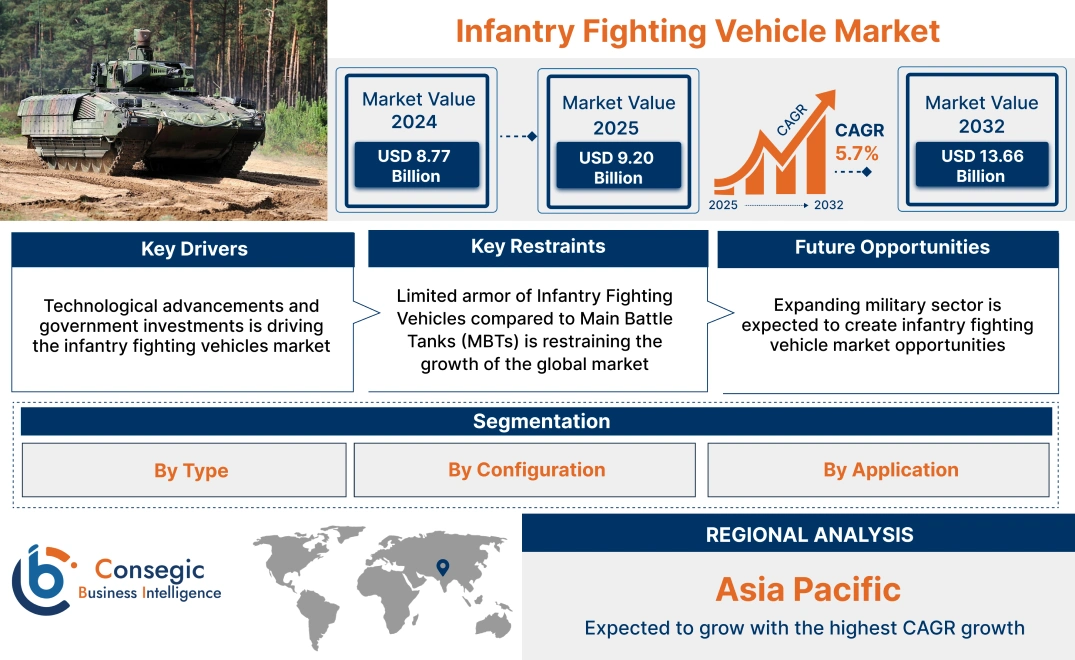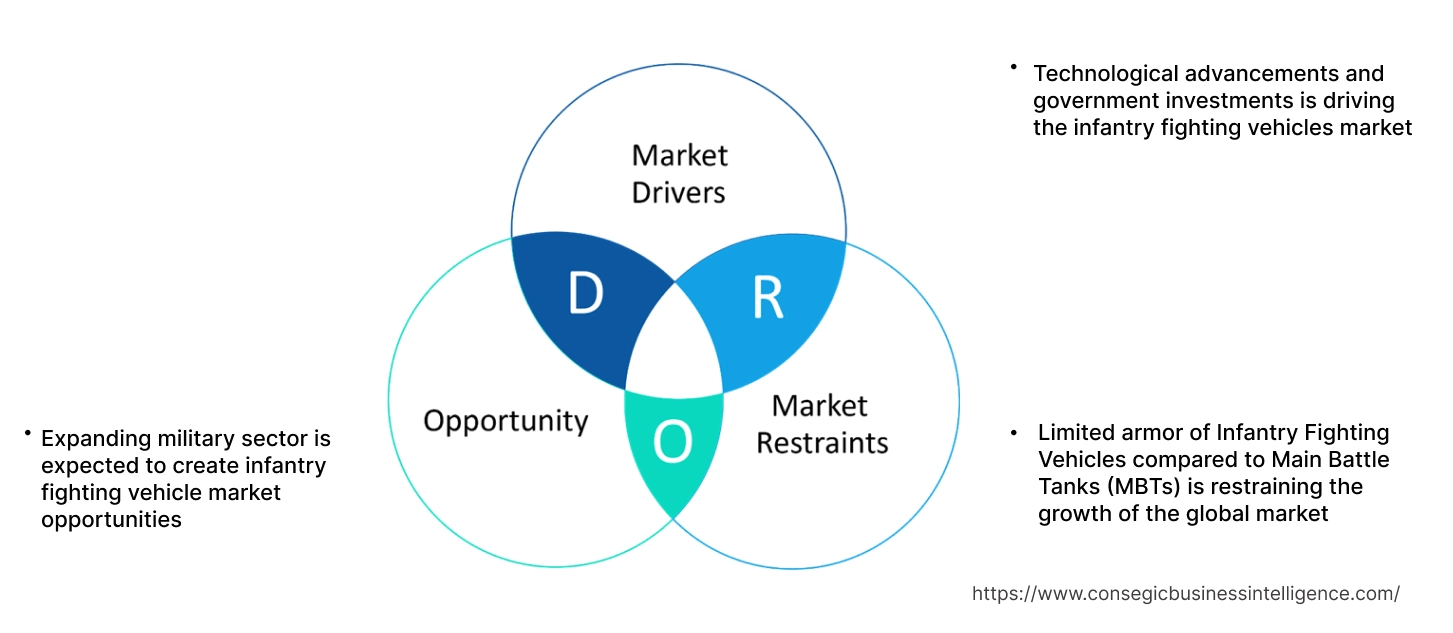- Summary
- Table Of Content
- Methodology
Infantry Fighting Vehicle Market Size:
Infantry Fighting Vehicle Market Size is estimated to reach over USD 13.66 Billion by 2032 from a value of USD 8.77 Billion in 2024 and is projected to grow by USD 9.20 Billion in 2025, growing at a CAGR of 5.7% from 2025 to 2032.
Infantry Fighting Vehicle Market Scope & Overview:
An Infantry Fighting Vehicle (IFV) is an armored combat vehicle designed to transport and support infantry soldiers in battle. Unlike Armored Personnel Carriers (APCs) which primarily focus on troop transport, these vehicles are equipped with significant firepower, including a powerful autocannon and anti-tank missiles. This allows them to provide direct fire support to the infantry they carry and engage enemy armored vehicles. Additionally, these vehicles are crucial for modern mechanized infantry units, enhancing their mobility, firepower, and survivability on the battlefield.
Key Drivers:
Technological advancements and government investments is driving the infantry fighting vehicles market
One of the most significant technological advancements is improved armor including the use of composite armor, which combines materials like ceramics, metals, and plastics to create lightweight yet highly protective armor. It also includes the use of reactive armor, which explosively reacts to incoming projectiles, deflecting them away from the vehicle. Additionally, active protection systems (APS) are being developed to detect and intercept incoming threats like missiles and rockets with countermeasures. Moreover, governments worldwide are modernizing their militaries to address evolving threats and maintain operational capabilities. IFVs are crucial components of modern mechanized infantry forces, leading to increased demand.
- For instance, in Dec 2024, Denmark and Sweden signed a joint procurement contract worth SEK 25 billion (approximately USD 2.3 billion) with BAE Systems for 205 new Combat Vehicle 90 (CV9035 MKIIIC) vehicles. This agreement will see Denmark receive 115 vehicles, while Sweden will acquire 50. Additionally, 40 vehicles will be donated to Ukraine.
- Thus, as per the analysis, the technological advancements and increasing investment by the government is driving the infantry fighting vehicle market share.
Key Restraints:
Limited armor of Infantry Fighting Vehicles compared to Main Battle Tanks (MBTs) is restraining the growth of the global market
Infantry fighting vehicles are more vulnerable to anti-tank weapons including RPGs, ATGMs, and even some autocannons leading to higher casualty rates in combat situations. Additionally, the lighter armor restricts their ability to operate in high-threat environments where they encounter heavier enemy armor, limiting the operational flexibility and effectiveness in certain combat scenarios. Moreover, MBTs, despite the higher cost, offer a greater sense of security and battlefield dominance, becoming a more attractive option for some militaries.
Thus, as per the infantry fighting vehicle market analysis, presence of alternatives including MBTs is impeding the infantry fighting vehicle market growth.
Future Opportunities :
Expanding military sector is expected to create infantry fighting vehicle market opportunities
As militaries around the world are expanding their capabilities, there will be a growing demand for a wide range of military equipment. Additionally, the increased spending on military equipment and the associated economic activity is expected to contribute to overall economic growth in countries with a strong defense industry.
- For instance, in April 2024, according to Stockholm International Peace Research Institute (SIPRI), global military spending surged to a record high of USD 2.443 trillion in 2023, marking a 6.8% increase from the previous year and represents the sharpest annual rise since 2009. The ten largest military spenders, led by the United States, China, and Russia, all contributed to this significant increase.
- Hence, based on the analysis the expanding military sector presents significant infantry fighting vehicle market opportunities.
Infantry Fighting Vehicle Market Segmental Analysis :
By Type:
Based on the type, the market is bifurcated into wheeled and tracked.
Trends in the Type:
- Wheeled vehicles tend to be more fuel-efficient, reducing operational costs and offer better mobility on roads and in urban environments.
- Tracked vehicles maintain an edge in off-road mobility and carry heavier weapons and armor.
The tracked segment accounted for the largest revenue share in 2024
- New tracked vehicles are being equipped with more powerful weapons, such as larger caliber cannons and anti-tank guided missiles, to counter evolving threats, driving the tracked infantry fighting vehicle market trend.
- Tracked infantry fighting vehicles offer superior mobility on rough terrain and better protection against threats compared to wheeled vehicles, crucial for modern warfare scenarios.
- Ongoing advancements including air-tight inner space with filter-ventilation devices to provide good protection against the blast wave are enhancing the capabilities.
- For instance, Ministry of Defence of the Czech Republic, adopted BVP-1, a formidable light combat amphibious tracked vehicle, designed for high maneuverability and equipped with substantial firepower and armored protection. Its arsenal includes a 73 mm cannon, a 7.62 mm machine gun, and anti-tank guided missiles, enhancing the offensive capabilities of mechanized units. Notably, the BVP-1 incorporates robust protection measures, such as airtight compartments and filtration systems, ensuring the safety of its crew even in environments contaminated by weapons of mass destruction.
- Thus, as per the analysis, the aforementioned factors are driving the infantry fighting vehicle market size.
The wheeled segment is expected to register the highest CAGR over the forecast period
- Wheeled vehicles generally have lower maintenance costs and require less logistical support compared to tracked vehicles.
- 8x8 Wheeled offer a good balance of mobility, firepower, and protection and are equipped with more powerful weapons, such as larger caliber cannons and anti-tank guided missiles.
- Additionally, advanced armor and active protection systems are being integrated in 8x8 wheeled to enhance the survivability of these vehicles and is also driving the market trend.
- For instance, Tata Advanced Systems unveiled WhAP 8x8, India's first amphibious wheeled infantry combat vehicle.Developed in collaboration with DRDO, WhAP integrates advanced technologies like an integrated power pack and automatic transmission, ensuring all-terrain performance and amphibious capabilities.Designed for optimal survivability and lethality, WhAP's modularity allows for customization to suit various mission requirements.Furthermore, rigorous testing across diverse terrains and climatic conditions has validated the platform's performance, benchmarking it against global best-in-class products.
- Therefore, as per analysis, the aforementioned infantry fighting vehicle market trends are expected to continue driving expansion in the wheeled infantry fighting vehicle market size in the coming years.
By Configuration:
Based on the configuration, the market is segmented into amphibious and non-Amphibious.
Trends in the Configuration:
- Non-amphibious are being equipped with more potent weapons, including larger caliber cannons and anti-tank guided missiles (ATGMs), to counter evolving threats.
- Amphibious are also benefiting from technological advancements, with a focus on improving their water mobility and survivability in aquatic environments.
The non-amphibious segment accounted for the largest revenue share in 2024
- Non-amphibious operate effectively across a broad range of environments, including deserts, forests, mountains, and urban areas, suitable for a wider range of military operations compared to their amphibious counterparts.
- Most military operations primarily focus often on land-based combat, making non-amphibious an ideal option for many armed forces, which in turn is driving the market trend.
- Non-amphibious generally have a lower development and maintenance cost compared to amphibious vehicles, crucial for many countries with limited defense budgets.
- A significant portion of research and development efforts in the market are directed towards enhancing non-amphibious capabilities, such as advanced fire control systems, active protection systems, and improved armor protection.
- Overall, the combination of versatility, operational requirements, cost-effectiveness, and technological focus are driving the market size.
The amphibious segment is expected to register the highest CAGR over the forecast period
- Many nations are increasingly focusing on their maritime interests and coastal defense, which necessitates the development and acquisition of amphibious vehicles, including IFVs, for effective operations in these environments.
- Modern warfare increasingly involves complex operations in littoral zones, including island hopping, amphibious assaults, and operations in riverine environments and amphibious vehicles provide crucial capabilities for these scenarios.
- Moreover, the integration of advanced technologies including night vision and smoke grenade is also contributing notably in boosting the market growth.
- For instance, BMP-II, also known as 'Sarath' in India, is a formidable Infantry Combat Vehicle (ICV). The fully tracked, amphibious vehicle boasts a 30mm cannon, a 7.62mm machine gun, and anti-tank missiles. It can carry seven troopers and three crew members while offering protection against NBC attacks. Equipped with night vision and smoke grenade launchers, the BMP-II is a highly mobile and versatile asset for modern warfare.
- These factors are predicted to contribute to the amphibious infantry fighting vehicles market expansion.
By Application:
Based on the end user, the market is segmented into Combat, Armoured Reconnaissance, Patrolling, and Others.
Trends in the Application:
- IFVs designed for reconnaissance are typically lighter and more agile, equipped with advanced sensors and surveillance equipment.
- These vehicles often prioritize protection against asymmetric threats and may incorporate features like mine-resistant ambush-protected (MRAP) technology.
Combat accounted for the largest revenue share of 44.3% in the year 2024
- A move towards larger caliber main guns (e.g., 30mm to 40mm) is evident to counter increasingly sophisticated threats.
- Incorporation of Active Protection Systems (APS) to counter incoming threats like rockets and missiles and the use of advanced composite materials to provide better protection against ballistic and blast threats.
- Development of advanced suspension systems for better off-road mobility and ride comfort and exploration of hybrid propulsion systems for increased fuel efficiency and reduced emissions.
- Furthermore, the increasing innovations by key players in developing vehicles suitable for combat operations is also propelling the market growth.
- For instance, Puma infantry fighting vehicle, a joint venture between Rheinmetall and KNDS, stands as a pinnacle of modern technology. Its advanced modular protection, adaptable firepower, and network-centric capabilities provide unparalleled combat effectiveness. Designed to transport and support a nine-man crew, the Puma boasts exceptional mobility, including the capacity for airlift by the A400M transport aircraft, ensuring rapid deployment to any operational theater.
- Therefore, the aforementioned factors are contributing significantly in accelerating the infantry fighting vehicle market share.
The armored reconnaissance segment is expected to register the highest CAGR over the forecast period
- Modern warfare increasingly relies on timely and accurate intelligence. Armored reconnaissance vehicles equipped with advanced sensors, surveillance systems, and communication technologies play a crucial role in gathering vital battlefield information.
- The need for rapid deployment and real-time situational awareness is paramount in modern conflicts. Armored reconnaissance vehicles, with their mobility and advanced sensors, quickly gather intelligence and transmit it to command centers, enabling faster decision-making and more effective responses.
- The rise of asymmetric threats, such as terrorism and insurgency, necessitates agile and adaptable forces. Armored reconnaissance vehicles can be effectively employed in counter-insurgency operations, providing mobility, protection, and reconnaissance capabilities in challenging environments.
- Subsequently, these factors are driving the demand for armored reconnaissance IFVs, leading to infantry fighting vehicle market expansion.
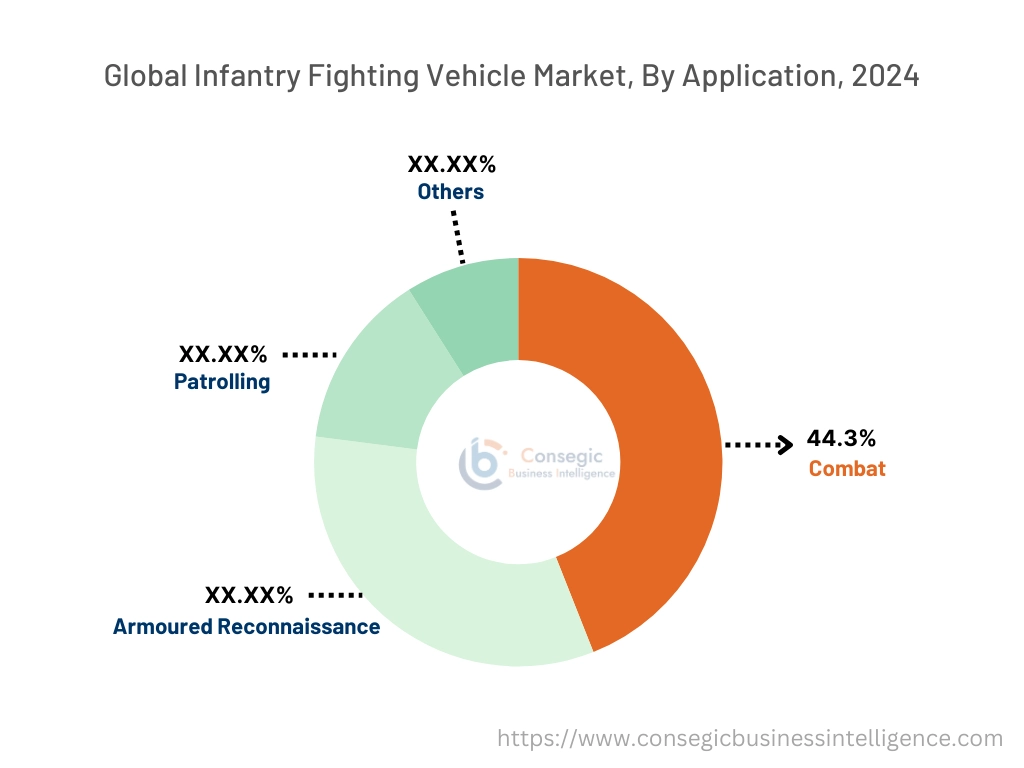
Regional Analysis:
The global infantry fighting vehicle market has been classified by region into North America, Europe, Asia-Pacific, MEA, and Latin America.
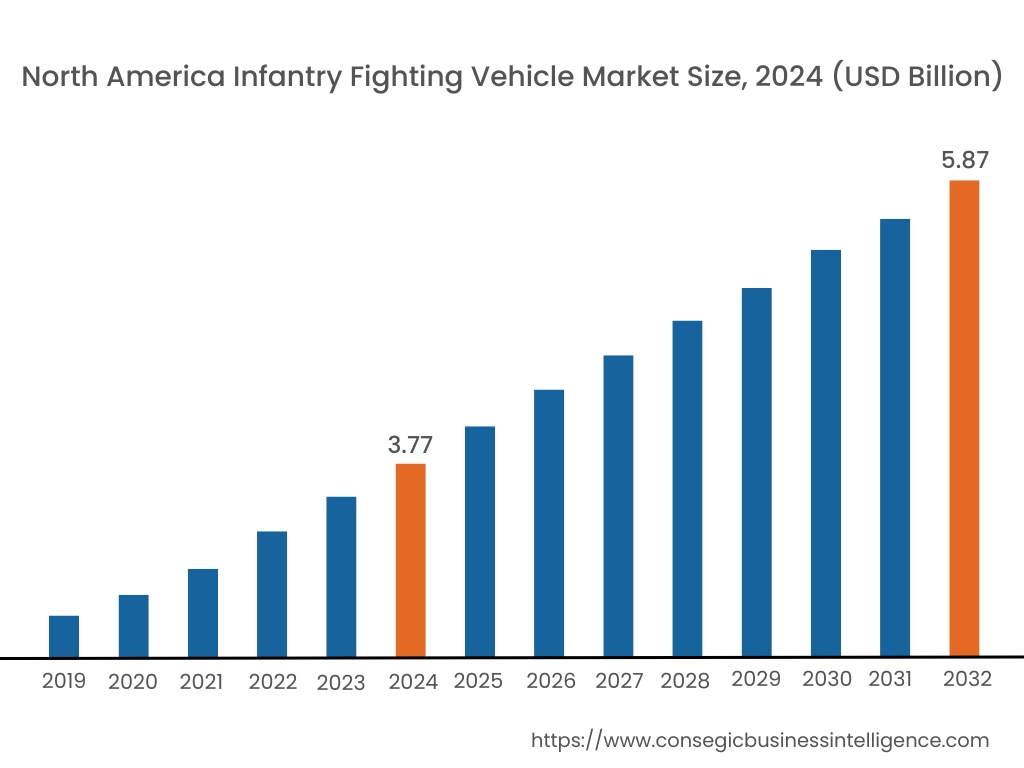
North America region was valued at USD 3.77 Billion in 2024. Moreover, it is projected to grow by USD 3.96 Billion in 2025 and reach over USD 5.87 Billion by 2032. Out of these, U.S. accounted for the largest revenue share of 77.1% in 2024.
The U.S. government actively supports its defense industry through research and development funding, procurement contracts, and export promotion initiatives fostering a favorable environment for manufacturers to thrive. The region's manufacturers have established strong export networks, selling their products to allied nations and other countries seeking advanced military equipment. Moreover, the United States, possesses a large and well-funded military that consistently invests in modernizing its armored vehicle fleet, creating a significant domestic market for manufacturers.
- For instance, in August 2023, American Rheinmetall Vehicles and Team Lynx have secured a contract exceeding USD 700 million for Phases 3 and 4 of the U.S. Army's XM30 program. This significant win allows them to proceed with the detailed design and prototype development of the Lynx OMFV, a cutting-edge Infantry Combat Vehicle boasting advanced protection, superior firepower, exceptional mobility, and an adaptable open systems architecture.
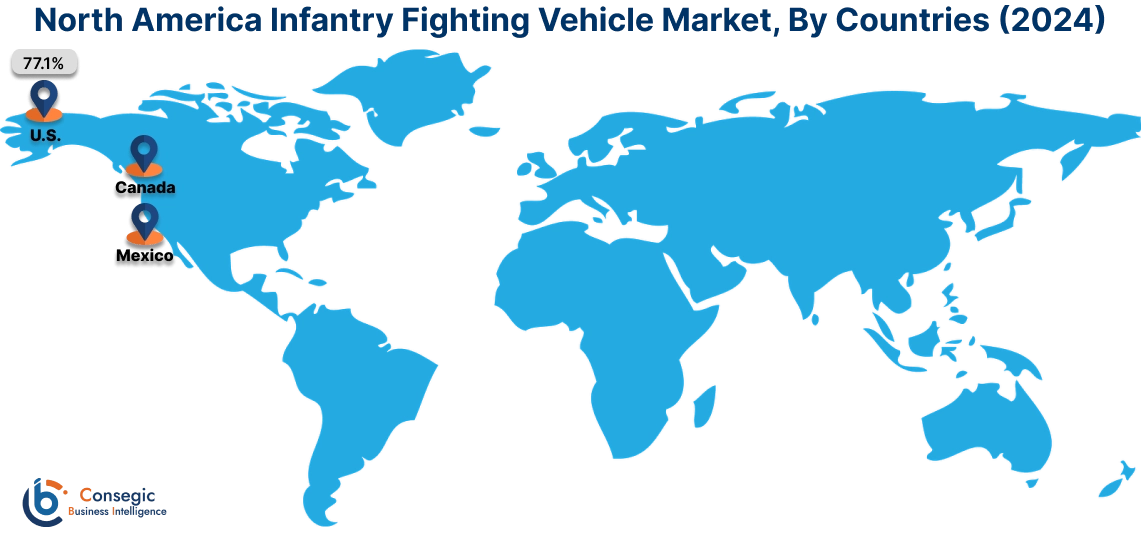
Asia Pacific region was valued at USD 2.37 Billion in 2024. Moreover, it is projected to grow by USD 2.49 Billion in 2025 and reach over USD 3.77 Billion by 2032.
Increased tensions between nations in the region are driving significant military modernization efforts, including the acquisition of advanced vehicles. In addition, many countries in Asia Pacific are actively upgrading their military capabilities, replacing aging equipment with modern, technologically advanced vehicles. Moreover, concerns related to terrorism, insurgency, and border security are also expected to drive infantry fighting vehicle market demand for internal security operations.
- For instance, in Jan 2025, China's People's Liberation Army Air Force (PLAAF) Airborne Corps has begun deploying a new generation of air-droppable IFV, replacing the older ZBD-03 model. Developed by Norinco, these advanced vehicles significantly enhance the PLAAF's airborne capabilities, demonstrating China's continued military modernization efforts.
As per the infantry fighting vehicle market analysis, many European nations maintain substantial military forces and actively invest in modernizing their armored vehicle fleets, creating a significant market within the region. Moreover, in Latin America internal security concerns, such as counter-insurgency operations and border control, are driving the infantry fighting vehicle market demand. Additionally, several countries in the region are modernizing their militaries to enhance their capabilities and regional influence. Furthermore, in the Middle East & Africa regional conflicts, counter-terrorism operations, and border security concerns drive the demand for advanced military equipment, including IFVs. Many countries in the region are actively modernizing their militaries and investing heavily in defense capabilities.
Top Key Players and Market Share Insights:
The market is highly competitive with major players providing casino management solutions to the national and international markets. Key players are adopting several strategies in research and development (R&D), product innovation, and end-user launches to hold a strong position in the market. Key players in the infantry fighting vehicle industry include-
- Rheinmetall (Germany)
- General Dynamics Land Systems (United States)
- Krauss-Maffei Wegmann GmbH & Co. KG (Germany)
- Paramount Group (South Africa)
- Saab AB (Sweden)
- BAE Systems (United Kingdom)
- Kurganmashzavod (Russia)
- Hyundai Rotem (South Korea)
- FNSS SavunmaSistemleri A.Ş. (Turkey)
- Iveco - Oto Melara Consortium (Italy)
Recent Industry Developments :
Partnerships & Collaborations:
- In December 2024, Rheinmetall received another order from the German government to supply Ukraine with 20 Marder 1A3 infantry fighting vehicles. This delivery, scheduled for the first half of 2025, is part of ongoing efforts to support Ukraine's defense against Russia.
- In October 2024, Italian defense giant Leonardo and German defense contractor Rheinmetall established a 50/50 joint venture, Leonardo Rheinmetall Military Vehicles (LRMV), to develop and produce military combat vehicles in Europe. This partnership aims to create a European leader in the field, leveraging the strengths of both companies.
Infantry Fighting Vehicle Market Report Insights :
| Report Attributes | Report Details |
| Study Timeline | 2019-2032 |
| Market Size in 2032 | USD 13.66 Billion |
| CAGR (2025-2032) | 5.7% |
| By Type |
|
| By Configuration |
|
| By Application |
|
| By Region |
|
| Key Players |
|
| North America | U.S. Canada Mexico |
| Europe | U.K. Germany France Spain Italy Russia Benelux Rest of Europe |
| APAC | China South Korea Japan India Australia ASEAN Rest of Asia-Pacific |
| Middle East and Africa | GCC Turkey South Africa Rest of MEA |
| LATAM | Brazil Argentina Chile Rest of LATAM |
| Report Coverage |
|
Key Questions Answered in the Report
How big is the Infantry Fighting Vehicle market? +
The Infantry Fighting Vehicle Market Size is estimated to reach over USD 13.66 Billion by 2032 from a value of USD 8.77 Billion in 2024 and is projected to grow by USD 9.20 Billion in 2025, growing at a CAGR of 5.7% from 2025 to 2032.
What specific segmentation details are covered in the infantry fighting vehicle report? +
The infantry fighting vehicle report includes specific segmentation details for type, configuration, application, and regions.
Which is the fastest segment anticipated to impact the market growth? +
In the infantry fighting vehicle market, the wheeled is the fastest-growing segment during the forecast period.
How big is the Infantry Fighting Vehicle market? +
The Infantry Fighting Vehicle Market Size is estimated to reach over USD 13.66 Billion by 2032 from a value of USD 8.77 Billion in 2024 and is projected to grow by USD 9.20 Billion in 2025, growing at a CAGR of 5.7% from 2025 to 2032.
What specific segmentation details are covered in the infantry fighting vehicle report? +
The infantry fighting vehicle report includes specific segmentation details for type, configuration, application, and regions.
Which is the fastest segment anticipated to impact the market growth? +
In the infantry fighting vehicle market, the wheeled is the fastest-growing segment during the forecast period.
